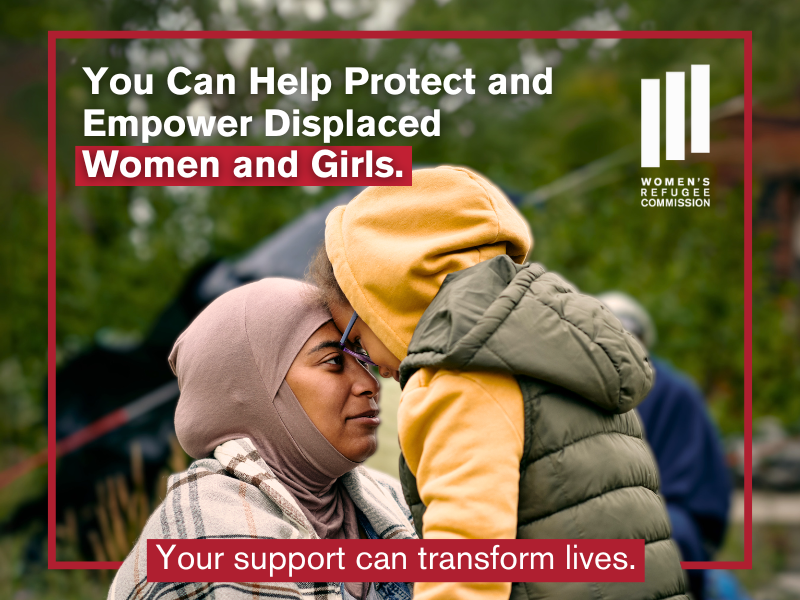“I really, really appreciate this workshop … I had no one to meet and talk to – no chance like this.” Soe Meh* was quiet and attentive, making valuable contributions while keeping a watchful eye on her baby as she was passed among many admirers. She presented her unique perspective to the participants attending the Women’s Refugee Commission/UNHCR workshop. As a young woman and mother with disabilities, she illuminated some of the challenges, skills and capacities that 6.7 million[1] displaced persons with disabilities have in accessing and contributing to humanitarian programs.
Disability Inclusion: Translating Policy into Practice in Humanitarian Action, the Women’s Refugee Commission’s (WRC’s) newly released report, draws on the wisdom of over 770 displaced persons, including persons with disabilities, their families and nearly 400 humanitarian actors. The report outlines obstacles, as well as promising field practices for maximizing their inclusion. It provides concrete suggestions for actors across the humanitarian field, including humanitarian organizations, donor governments, the UN refugee agency and disabled persons’ organizations.
Persons with disabilities are among the most excluded and isolated in the aftermath of persecution and conflict, violence and human rights violations. They have difficulty accessing humanitarian assistance programs due to a variety of societal, environmental and communication barriers. Many are hidden in shelters, overlooked in needs assessments and excluded when programs are designed. Discrimination and careless planning prevent people like Soe Meh from accessing needed services, and it blocks them from contributing to program planning. Social discrimination distances them from their community. This increases their vulnerability to a variety of protection concerns—such as violence, abuse and exploitation—particularly for women and children.
Their capacity is tremendous, however, and well-placed strategies can effectively promote their inclusion. Soe Meh contributed greatly to action planning in our workshop, which was jointly organized with the United Nations High Commissioner for Refugees (UNHCR). She shared her experiences and perspectives as a refugee, as a young woman with disabilities and as the mother of a new baby. She provided insight into both problems and solutions. Her contributions highlighted just what the humanitarian sector risks losing when persons with disabilities are excluded.
The WRC has been raising awareness about the concerns of refugees with disabilities since 2008. Through research, capacity development and advocacy, we have promoted disability-inclusive policy and practice. The WRC has provided technical support and training to UNCHR country operations and partners following the agency’s Conclusion on Refugees with Disabilities (2010) and the launch of UNHCR guidance on Working with persons with disabilities in forced displacement. To date, we have worked with these programs in eight countries—India (New Delhi), Uganda, Thailand, Bangladesh, Nepal, Ethiopia, Philippines (Mindanao) and Lebanon. These consultations form the foundation of the Disability Inclusion: Translating Policy into Practice in Humanitarian Action.
We have recognized a growing awareness among UNHCR staff and partners about the needs of persons with disabilities; we have seen increasing attempts to promote their inclusion in programs and activities. Positive approaches being undertaken at field levels include:
- Engaging refugees with disabilities as partners and collaborators—not only as beneficiaries—in ways that take their specific circumstances into account
- Working with women with disabilities in Nepal to strengthen their assets and skills
- Training case managers in Lebanon to recognize the increased risks that persons with disabilities experience, and providing them with the tools to take appropriate steps to decrease this vulnerability
Despite this progress, there continues to be a gap in capacity to provide ongoing and consistent technical support to humanitarian actors at field levels. There is also a need to document what works in different contexts, and in different phases of a crisis.
Persons with disabilities are a diverse group of people – they have different types of disabilities, and a wide array of needs, skills and capacities. They are the best people to advise us on ideas and approaches to promote inclusion in their given contexts. They can and should be involved as partners in humanitarian action. Our next challenge is to ensure that this participation is representative of women, children and youth with disabilities, especially those who have intellectual and metal disabilities, and those experiencing extreme isolation. For Soe Meh, her goal is to one day become a trainer, “because I still need to do this myself, and I think it can help others.”


